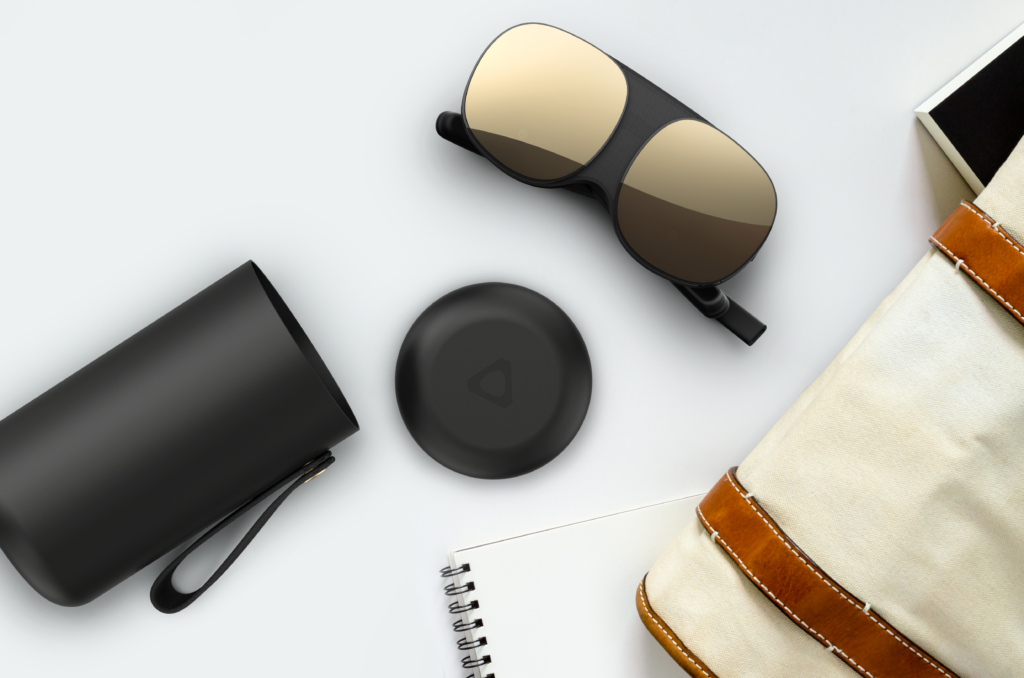HTC’s lightweight VR device is designed primarily for lifestyle and light entertainment.
HTC today unveiled the Vive Flow, a portable VR glasses device. Unlike existing VR headsets such as the HTC Vive or Oculus Quest 2, the Vive Flow is aimed primarily at mental and physical wellness rather than AAA gaming or enterprise. The glasses are smaller, lighter, and more wieldy than a VR headset, making it a convenient option for those seeking a more portable VR device. The glasses even feature their own dedicated carrying case.
The 6DoF VR glasses feature a 100-degree field-of-view and 3.2K resolution with a refresh rate of 75 Hz. In addition to built-in 3D spatial audio, you also have the option of pairing your own Bluetooth headphones. Now, here’s where things get interesting. Rather than using standard motion controllers to interact with content, you instead use your Android smartphone as a single 3DoF remote control. It sounds a bit strange in writing, but once you’ve spent a few minutes “in-glasses,” you’ll be navigating the Vive Flow UI with ease. The company has also teased support for “gaze-based” interactions.
The Vive Flow is aimed at wellness and passive entertainment, removing the need for a complex control scheme. That said, the device is capable of light VR gaming, though I wouldn’t consider it a major selling point. Still, I like how the Vive Flow offers a little bit of something for everyone.
“With VIVE Flow, HTC is taking technology in a new direction, focusing not on what we do, but on how we feel. Maintaining our wellness has come to the forefront in the last few years, with so many millions feeling stressed every day, so it has never been more important to take time out to calm our minds, and VIVE Flow provides the perfect opportunity to escape our four walls and immerse ourselves in our ideal ambiance,” said Cher Wang, Chairwoman and CEO of HTC, in an official release.
“Meditation, gentle stretches, brain training, streaming our favorite shows or even meeting friends or coworkers in VR with VIVE Sync can all be enhanced by a device light and compact enough to fit in our pocket,” added Wang. “VIVE Flow represents the next evolution of technology, as we take a more holistic view of how we can make life better.”
We were lucky enough to go hands-on with the Vive Flow ahead of today’s announcement, and while our time with HTC’s unique device was short, we can already see its potential as a comfortable wellness and entertainment device. Of course, it’s important to note that the software we tried during our demo is subject to change. With that out of the way, let’s jump straight into our initial impressions:
The Design
Holding the glasses for the first time, the first thing I noticed was the weight; it’s virtually nonexistent. The Vive Flow weighs approximately 189g (less than a pound). According to HTC, that’s about the same weight as your standard chocolate bar, and I’m inclined to agree. This is not a VR headset, this is a pair of VR glasses. The Vive Flow is easily one of the lightest VR devices I’ve ever worn.
The glasses don’t wrap entirely around your head. Instead, the device sits on your dome like a pair of sunglasses. A dual-hinge design promises compatibility with a wide range of head shapes, removing the need for different size models. Light blockers located on the magnetic face gasket do a fantastic job of immersing you in your content. There’s even an active cooling system that removes hot air, preventing fog.
The headset itself is wireless, save for the tethered power supply that’s required in order to operate. For the best results, HTC recommends using its official 10,000mAh Vive power bank, though the company states that a third-party external battery of the same power will also work. You can also plug the glasses directly into your smartphone for maximum convenience, though it will drain your battery, shortening your overall use-time.
The front of the headset features a gorgeous mirror-like front plate similar to that of a dragonfly. According to HTC, this is purely an aesthetic choice. Behind the plate, however, you’ll find several built-in cameras that allow for inside-out tracking, removing the need for external trackers.
One feature I found particularly interesting was the manual IPD adjustment. The Vive Flow allows you to adjust the IPD of each lens individually. According to those I spoke with during my demo, these asymmetrical diopter dials are designed to serve a variety of uses-cases. Speaking of uses-cases, let’s talk about software.
The Content
As mentioned earlier, the HTC Vive Flow is aimed at wellness and light entertainment. This can include everything from meditation and yoga to watching movies and participating in various brain-training exercises. You can even mirror your smartphone to the headset, allowing you access to all of your games and apps in VR. Using a paired Android smartphone, I went hands-on with several of these experiences.
The first app I tried was a reimagining of VR developer Starcade Arcade’s Snake-like VR game Space Slurpies. In this colorful multiplayer experience, players take control of their own adorable worm using their motion controllers and navigate an increasingly complex battlefield in search of delicious food pellets and smaller players to consume. Space Slurpies on Vive Flow offers a near-identical experience, only instead of motion controllers, you control the snake using your smartphone’s gyroscopic technology. I’ll admit I found the controls a bit confusing at first, but ultimately I found the learning curve surprisingly easy.
I also spent time with several non-interactive experiences designed to promote mental wellbeing. This includes TRIPP, a popular VR mediation app that was originally launched on the Oculus Go. This VR mindfulness app is a perfect fit for the Vive Flow, allowing users to quickly jump in and out of meditative sessions whenever they begin feeling stressed.
“Relaxation means different things to different people,” said Nanea Reeves, CEO of leading XR wellness service TRIPP. “It’s important to find your own version of zen, whether that means meditating, watching videos, or playing games. The fact that HTC gets it, that we can use VR in these ways that can benefit peoples’ emotional and mental well-being is something that I personally am very excited about as is our entire team at TRIPP.”
There’s also MyndVR, a VR platform designed to assist seniors fighting isolation. The company recently announced a new original series, A Road to Remember. In this multi-part adventure, seniors are taken on a trip down the iconic Route 66. The aforementioned asymmetrical diopter dials are especially useful in this regard, allowing seniors suffering from visual impairments to better adjust their visuals for the optimal viewing experience. These are just a few examples of the various types of content on their way to the Vive Flow. This includes everything from meditation and entertainment to productivity and brain-training. More content will be available via the Viveport app on Android smartphones.
The HTC Vive Flow will be available this November for USD $499 / £499 at vive.com/vive-flow. Pre-orders begin October 14th around the world. The company will also be offering a dedicated Vive Flow carry case. Those who pre-order will score the carrying care, two months of the new-and-improved Viveport Infinity (USD $5.99 per month), and a gift bundle that includes seven pieces of content for free. According to the team, the Vive Flow carry case does not feature any charging capabilities.
Personally, I’m excited to see the direction in which the Vive Flow takes. With an excess of VR gaming hardware on the market, it’s interesting to see an immersive device dedicated entirely to lifestyle, wellbeing, and light entertainment. While the Vive Flow might not win any awards with the gaming community, it could be the perfect option for those seeking a more comfortable and convenient VR experience, especially for those constantly on the go.
We’re excited to spend more time with the Vive Flow and offer a full review in the near future. For more information on the Vive Flow visit here.
Feature Image Credit: HTC
The post Hands-On With The New HTC Vive Flow VR Glasses appeared first on VRScout.











